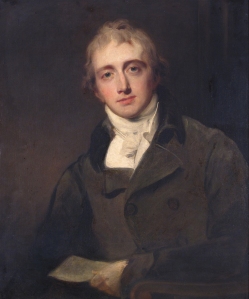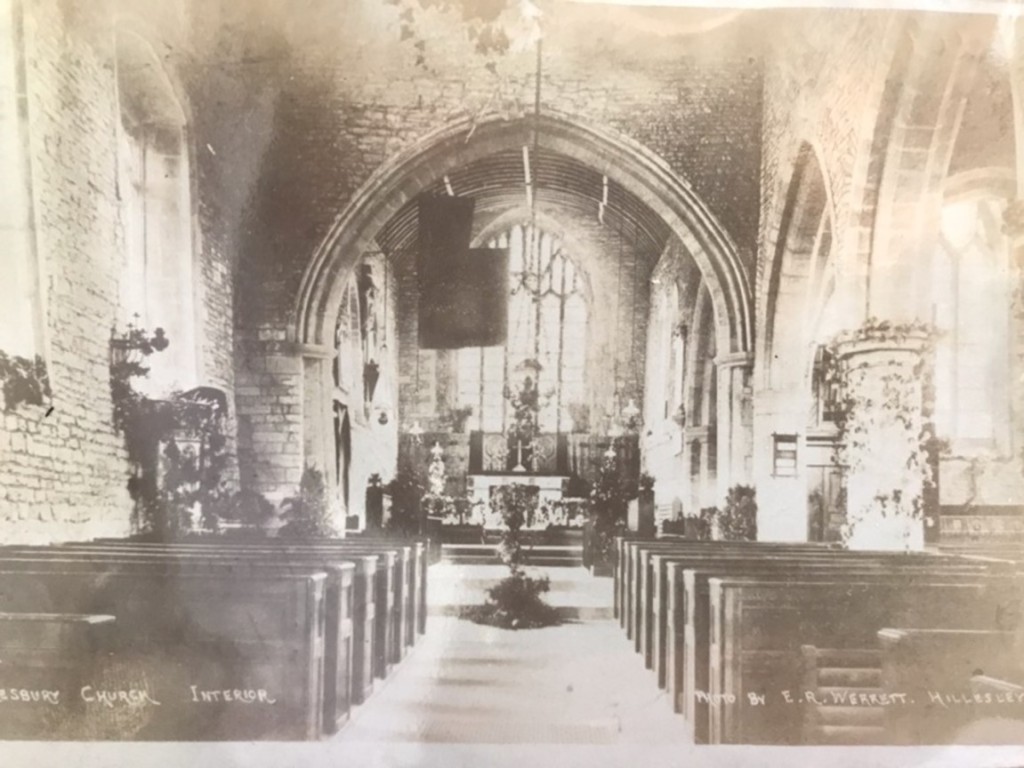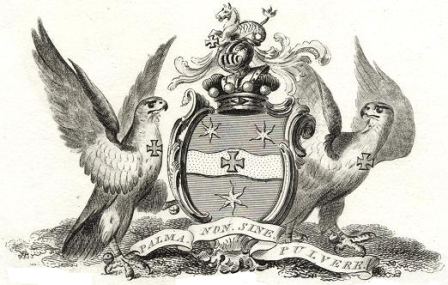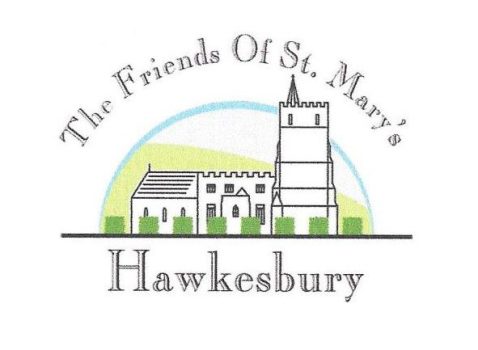
Robert Banks Jenkinson, 2nd Earl of Liverpool 1770-1828
The two heraldic banners hanging in St Mary’s Church, Hawkesbury, newly restored and rehung, carry the arms of Robert Banks Jenkinson (1770-1828), Baron Hawkesbury and 2nd Earl of Liverpool, one of Britain’s outstanding statesmen and the third longest-serving of all British Prime Ministers. The banners are the only two that survive from perhaps at least seven which once hung in the chancel of St Mary’s, each with a small pennant or pennoncel with St. George’s cross at its head. Brackets for the banners and pennants still survive in situ.
A postcard of the 1890’s shows the banners hanging on either side of the memorial tablet to Lord Liverpool, opposite that of his father, the first Earl. At a later date the banners were moved to the south west corner of the church, where they suffered considerable damage from direct sunlight and movement over radiators. The banners were conserved in 2021 by Alison Lister of Textiles Conservation Ltd, Bristol, generously funded by Lord Liverpool, members of the Jenkinson family and grants from the Leche Trust, Pilgrim Trust, Church Care, and other private donors.

Heraldry

The larger banner has a field of sable, and in the centre are two large oval shields: the dexter one surrounded by the Garter (granted to Lord Liverpool in 1814 at the visit of the Allied Sovereigns to London) and bearing the arms of Jenkinson, the sinister one with the same arms in the centre between two impalements, on the dexter side Hervey, the arms of Lord Liverpool’s first wife, and on the sinister side, Bagot, the arms of his second wife. The motto is “Palma non sin pulvere (‘Victory not without toil’). The smaller banner has the Jenkinson crest, a seahorse assurgent Argent maned Azure supporting a Cross Pattée Gules surrounded by the Garter, beneath the Earl’s coronet.
Robert Banks Jenkinson was baptised on 29 June 1770, the eldest son of Charles Jenkinson (1729-1808) later Baron Hawkesbury and 1st Earl of Liverpool(1796) and Amelia Watts, daughter of the Governor of Fort William, Bengal and the colourful ‘Begum Johnson’ of Calcutta (d. 1812). Amelia died shortly after her only child’s birth and is buried in St. Mary’s, Hawkesbury. Charles Jenkinson was the close confidante of George III and had a successful career of public service in successive governments for over forty years, thus providing valuable experience and opportunity for his son to follow the same path.
Robert Banks Jenkinson was a descendant of Anthony Jenkinson (d. 1611), the famous seafarer, merchant and traveller, who undertook four diplomatic missions to Russia between 1558 and 1571, and whose son Robert Jenkinson purchased the Manor of Hawkesbury in 1621. The estate remained in the family’s possession until 2016, when it was purchased by the 11th Duke of Beaufort. Many members of the Jenkinson family are buried or commemorated in the chancel of St. Mary’s Church.
After education at Charterhouse and Christ Church, Oxford, Robert Bankes Jenkinson spent four months in Paris in 1789, witnessed the Fall of the Bastille, and in 1790-91 travelled to Italy and the Netherlands before taking his seat in Parliament as the Member for Rye at the age of 21. From then on he rose steadily in public office, and in 1795 married the Hon. Theodosia-Louisa Hervey, the third daughter of Frederick Augustus, Earl of Bristol and Bishop of Derry (1730-1803), creator of the immense neo-classical villa at Ickworth in Suffolk. In 1796 he succeeded his father as Baron Hawkesbury, and in 1801 became Secretary of State for Foreign Affairs in which capacity he negotiated the Treaty of Amiens with France, and later became Secretary of State for War and the Colonies under Spencer Perceval (1809), having succeeded his father as Earl of Liverpool in 1808. Following the assassination of Perceval in 1812, he became Prime Minister, and remained in post throughout the rest of the Napoleonic Wars, the War of 1812 with the United States, the Congress of Vienna and the period of domestic political instability following 1815.
After his first wife died in 1821, he married Lady Mary Chester, nee Bagot, whose arms also appear on his Garter Banner. In 1827 he suffered a severe stroke and retired from office, and died in December 1828 at his home in Kingston-upon-Thames. His corpse was brought, with his honours, to Hawkesbury for burial, and a memorial tablet erected to his memory many years later, with his banners, on the north wall of the chancel of St. Mary’s church. The two surviving banners appear in that position in early 20th-century photographs, but were removed to the south-west corner of the church at a later date, from where they have been removed for conservation assessment.
In the Gentleman’s Magazine’s obituary of Lord Liverpool in January 1829, the following assessment of him was published; ‘If the Earl of Liverpool was not a man of brilliant genius, or lively fancy, he was possessed of powerful talents, sound principles and unimpeachable integrity. He seemed born to be a statesman.’

Ickworth (National Trust)
Hawkesbury’s Grandest Funeral?
Much has been discussed recently in the media about the expense of funerals. This historical note comes as a reminder that such occasions, especially for a Prime Minister, were taken very seriously.
An extract from the Wotton-under-Edge Gazette for March 1927 gives an interesting account of the funeral of Robert Bankes Jenkinson, 2nd Lord Liverpool, who died in London on 4th December 1828 following a second series of strokes and the interment of his corpse took place in the family vault at Hawkesbury church four days later on December 8th 1828.
The Gazette recorded that ‘For the burial at Hawkesbury the body was taken by road, and the funeral carried out with pomp and ceremony, hardly credible today.
‘The funeral account contained no less than 188 items, the total cost reaching the huge sum of £1,352 (that would equal roughly £10,600 in 2021). Under three headings, funeral, Heraldry and ‘disimbelishments’:
- The undertaker’s time in attending the service £8.8s
- Among the 75 items for the funeral may be mentioned, a coffin, lined with quilted rich white satin, trimmed with rosettes £6.5.0
- A leaden coffin soldered complete £9.5s
- A mahogany coffin to receive the above trimmed with Genoa velvet, finished in the best manner, with brass handles, double rings of nails with raised coronets, the Order of the Garters £44.5.0
- Four porters on horseback £16.6s
- A very rich velvet cushion, trimmed with good fringes, very rich tassles £10.10s
- A rich mounted coronet and balls, velvet cap, velvet tassles £10 10s
- Hearse with six horses. Rich black Ostrich feathers £17.10s
- Mourning Coaches with six horses each £180
- Velvet and feathers for three coaches £12.12s
- Mourners to attend on journey to Hawkesbury £14.8s
- Six hoods and Scarves for men and servants £29.12s
- Sundry items £49.5s
- A superfine cloth for the pulpit and desk in family pew.
- A rich silk scarf and gloves for the minister and others £4.5.0 each
- Nine items of heraldry, coronets, crests, shields, garters £142
- Hire of twelve horses £72.
- Six banner bearers £13.0.0
- Messenger’s time, coach hire, and expenses at Hawkesbury to prepare Inns
- To open Vault £48.8.0
- Sundry Tolls, waterways on the journey, attendants £24.13s
- Twelve saddle horses, ostlers etc £18.10s.
